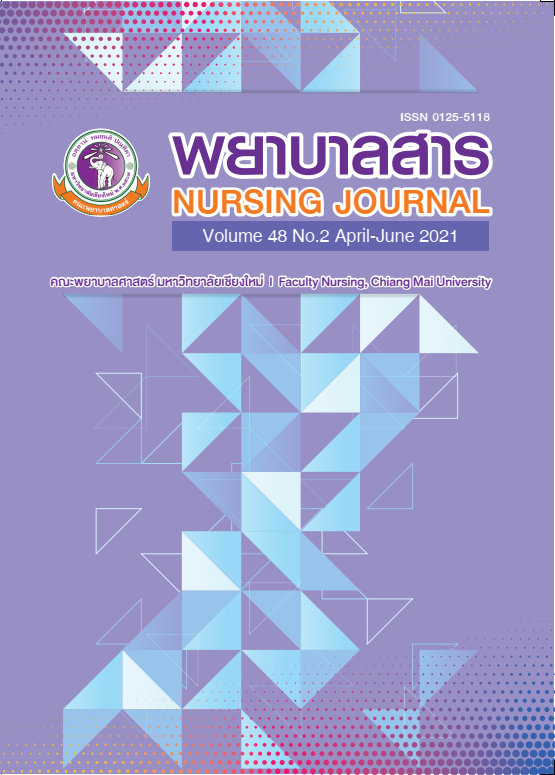Practices and Obstacles in Prevention of Ventilator-Associated Pneumonia Among Registered Nurses in Intensive Care Units
Keywords:
Ventilator-associated pneumonia, Practices, Obstacles, Prevention, Intensive Care UnitsAbstract
Correct practices in the prevention of ventilator-associated pneumonia (VAP) can prevent mechanically ventilated patients from getting hospital-acquired pneumonia. This descriptive study aimed to determine practices among registered nurses and their obstacles in the prevention of VAP. The sample included 262 registered nurses working in the Intensive Care Units (ICUs) of three tertiary care hospitals under the Ministry of Public Health. Data were collected from March to May 2018 using a self-administered questionnaire consisting of three parts: general information, practice, and obstacles in prevention of VAP. The content validity of the questionnaire was examined by six experts with a content validity index of 0.95 for practice and 0.94 for obstacles. The reliability of the practice and obstacle sections were 0.94 and 0.74, respectively. Data were analyzed using descriptive statistics.
The study results revealed that the participant practice of the following nine main prevention activities were at a good level: hand hygiene, patient positioning, caring of tracheostomy, practicing oral hygiene, suctioning, nasogastric tube feeding, weaning of ventilator, caring of the endotracheal tube and the ventilator circuit, and managing environment. However, the regular practice of the following activities were low: scrubbing hands completely for at least 30 seconds with water and antiseptic (44.7%) and measuring the endotracheal tube cuff pressure before suctioning (32.8%). Obstacles in the prevention of VAP included personnel, support and management. Significant obstacles identified were insufficient manpower (26.2%) and urgency in patient lifesaving (20.2%).
This study indicated the necessity of promoting correct hand hygiene practices and providing sufficient manpower so that registered nurses in the ICUs can effectively prevent VAP.
References
Aramrom, Y. (2015). Evidence-based practices in prevention of the ventilator-associated pneumonia (VAP). The Southern College Network Journal of Nursing and Public Health.2(3),144-158. (in Thai)
Beuret, P., Philippon, B., Fabre X., & Kaak, M. (2012). Effect of tracheal suctioning on aspiration past the tracheal tube cuff in mechanically ventilated patients. Retrieved from https://annalsofintensivecare.springeropen.com/articles/10.1186/2110-5820-2-45
Brooke, J., Deckera, K., & Palmorea, N. (2013). The Role of Water in Healthcare-Associated Infections. Current Opinion in Infectious Diseases. 26(4), 345–351.
Elsevier, B.V. (2016). The role of the intensive care unit environment and health-care workers in the transmission of bacteria associated with hospital acquired infections. Journal of Infection and Public Health, 9(1), 13-23.
Kawinam, P., Nguegngam, T., & Assawapalanggool, S. (2017). Effects of the development for promotional program for the implementation of ventilator associated pneumonia prevention-guidelines. Journal of Nursing Division, 44(3), 34-57. (in Thai)
Kollef, M. H., Chastre, J., Fagon, J. Y., François, B., Niederman, M. S., Rello, J., Torres, A., Vincent, J. L., Wunderink, R. G., Go, K. W. (2014). Global prospective epidemiologic and surveillance study of ventilator-associated pneumonia due to Pseudomonas aeruginosa. Critical Care Medicine, 42, 2178-2187.
Kollef, M. H., Hamilton, C., & Ernst, R. (2012). Economic impact of ventilator-associated pneumonia in a large matched cohort. Infection Control & Hospital Epidemiology, 33(3), 250-256.
Kraibut, K. (2008). Effects of promoting clinical practice guideline implementation on nurses’practices and incidence of ventilator-associated pneumonia in a general hospital (Master of Nursing Science, Infection Control Nursing). Graduate School, Chiang Mai University. (in Thai)
Mearkle, R., Houghton, R., Bwonya, D., & Lindfield, R., (2016). Barriers to hand hygiene in ophthalmic outpatients in Uganda: A mixed methods approach. Journal of Ophthalmic Inflammation and Infection. Retrieved from https://www.ncbi.nlm.nih.gov/pmc/articles/PMC4794470/pdf/12348_2016_Article_77.pdf
Polit, D. F., & Beck, C. T. (2004). Assessing data quality in nursing research: Principles and methods. Philadelphia: Lippincott Williams & Wilkins.
Ruksakun, P., Boonkartrum, N., Mepraseart, B., & Kraibut, K. (2012). Effect of developing a bundle of care for the prevention of ventilator-associated pneumonia in Sakon Nakhon hospital. Retrieved from http://203.157.168.41/fish_roop/web/r2r/data/VIGAI0280.docx
Ruttichoti, J. (2007). Nurses’ Practices for Preventing ventilator-associated pneumonia among patients in intensive care units of a regional hospital (Master’s thesis, Nursing Science in Adult Nursing). Songkhla University. (in Thai)
Srireaungrut, W. (2013). The development and evaluation of clinical nursing practice guideline for preventing ventilator-associated pneumonia in intensive care unit, Had yai Hospital (Master’s thesis, Nursing Science in Adult Nursing). Songkhla University. (in Thai)
The Infection Control Committee Surin Hospital. (2015). Infection control annual report Surin Hospital 2015. Infection Control Surin Hospital.
THIP. (2016). โครงการพัฒนาระบบสารสนเทศเปรียบเทียบวัดระดับคุณภาพโรงพยาบาล. Retrieved from http://www.ha.or.th/ha 2016/thip/thip.htm
Unahalekhaka, A., Lueang-a-papong, S., & Chitreecheur, J. (2014). Prevention of multidrug resistant organism infections in intensive care units. Faculty of Nursing, Chiang Mai University. Retrieved from kb.hsri.or.th/dspace/handle/11228/4265?locale-attribute=th
(in Thai)
World Health Organization. (2009). WHO guidelines on hand hygiene in health care. Switzerland: WHO Press. Retrieved from http://apps.who.int/iris/bitstream/10665/44102/1/9789241597906_eng.pd
Yamane, T. (1973). Statistics: An introductory analysis (2nd ed.). New York: Harper & Row.
Downloads
Published
How to Cite
Issue
Section
License
บทความที่ได้รับการตีพิมพ์เป็นลิขสิทธิ์ของวารสารพยาบาลสาร
ข้อความที่ปรากฏในบทความแต่ละเรื่องในวารสารวิชาการเล่มนี้เป็นความคิดเห็นส่วนตัวของผู้เขียนแต่ละท่านไม่เกี่ยวข้องกับมหาวิทยาลัยเชียงใหม่ และคณาจารย์ท่านอื่นๆในมหาวิทยาลัยฯ แต่อย่างใด ความรับผิดชอบองค์ประกอบทั้งหมดของบทความแต่ละเรื่องเป็นของผู้เขียนแต่ละท่าน หากมีความผิดพลาดใด ๆ ผู้เขียนแต่ละท่านจะรับผิดชอบบทความของตนเองแต่ผู้เดียว






